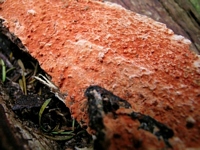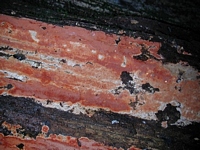|
 Gloeoporus taxicola Gloeoporus taxicola
SynonymsMeruliopsis taxicola
Merulius ravenelii
Poria taxicola
Xylomyzon taxicola
Merulius taxicola
BiostatusPresent in region - Indigenous. Non endemic
Images (click to enlarge)
Owner: J.A. Cooper | 
Owner: J.A. Cooper |
Article: Cunningham, G.H. (1963). The Thelephoraceae of Australia and New Zealand. New Zealand Department of Scientific and Industrial Research, Bulletin 145: 359 p. Wellington:.
Description: Hymenophore resupinate, annual, loosely attached, effused forming linear areas to 10 x 3 cm;
hymenial surface reddish-brown with a purple tinge, becoming vinaceous when old, at first
reticulateplicate, becoming porose-reticulate, pores 2-3 per mm, often with a linear
arrangement; margin irregular, 1-2 mm wide, byssoid, white, becoming darker with age,
loosely attached. Context white, to 400 µm thick, of loosely intertwined hyphae embedding
crystals, hyphae in the subhymenium encrusted with orange mucilage granules; generative
hyphae 3-4 µm diameter, walls 0.5 µm thick, to 1 µm towards the base, hyaline, without
clamp connections. Hymenial layer to 50 µm deep, a dense palisade of basidia, paraphyses,
and paraphysate hyphae. Basidia subclavate, 10-14 x 3-4 µm bearing 4 spores; sterigmata
slender, erect, to 4 µm long. Paraphyses subclavate, 8-12 x 3-3.5 µm. Paraphysate hyphae
filiform, projecting to 25 µm, tinted, 3-4 µm diameter. Spores allantoid, 4-5 x 0.75-1 µm,
walls smooth, hyaline, 0.1 µm thick.
Habitat: HABITAT: Effused on decorticated fallen branches.
Distribution: DISTRIBUTION: North America, Australia, Tasmania, New Zealand.
Notes: Absence of gloeocystidia and clamp connections, presence of paraphysate hyphae, the small
basidia, small allantoid spores, and reddish-brown or vinaceous surface of the hymenium
separate the species from others present in the region. Many collections resemble resupinate
forms of Polyporus merulinus Berk. in surface colour, and in size and shape of spores. They
may be separated by certain microfeatures, for P. merulinus is dimitic with clamp
connections in the generative hyphae. Although in North America confined to conifers, the species has been found both on conifers
and frondose hosts in New Zealand, and occurs mainly on Eucalyptus species in Australia.
|